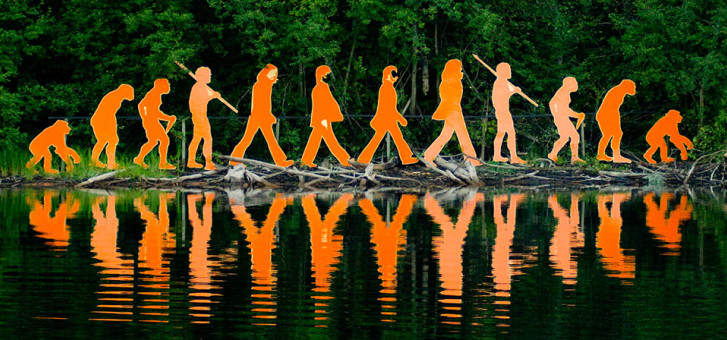Should schools teach an alternative to Darwin's 150-year-old theory of evolution? Ewan Ward and Lynden Rogers consider the debate.
Recent months have seen animated and highly polarised debate about Intelligent Design (ID), the so-called, largely Christian creationist response to evolutionary theory, in the press and on television. The primary question has been whether or not ID should be taught in a school's science curriculum.
The generally accepted scientific theory of origins may be usefully regarded as having two components, concerning life's beginning and subsequent development respectively.
Processes of chemical evolution are thought to have produced the primordial cell and hence the first life forms. This theory suggests that organic molecules formed from simple chemicals present in primordial oceans or water pools, which in turn aggregated to form larger, more complex molecules. These in turn spontaneously organised into very large complexes, known as macromolecules, such as protein, DNA and carbohydrate, eventually self-assembling into the first living cells.
If these processes were extraterrestrial, some transport mechanism must then have brought these cells to earth. The subsequent and random processes of mutation and natural selection, that is, Darwinian evolution, operating successively on these cells are then thought to explain the many and varied life forms that inhabit this planet today. Spontaneity and chance are key elements of this widely accepted view.
The problem is that as Charles Darwin attempted to understand and explain the connections between the myriad forms of life he had observed during his voyage on the Beagle , he knew nothing about the complex biochemical universe within these organisms. He didn't even know about cells; science had yet to develop the tools to investigate life at that level. Indeed, it is only within the past 30 years or so that the sophisticated equipment and methodologies of high-tech labs have revealed a working knowledge of cellular biochemistry. Interestingly, for a number of scientists, these revelations have significantly compromised the feasibility of the naturalistic explanation of life's origin and the Darwinian explanation for life's diversity described above.
The cell, the microscopic basic unit of life, self-repairing and replicating, is a molecule-packed, membranebound sac of watery protoplasm. It is a fantastic miniature factory full of molecular micromachines whose existence, structure and function is dependent upon the genetic information coded along the DNA molecule carefully coiled and packaged in the nucleus located near the centre (although some cells, such as bacteria do not have a nucleus as such). Indeed, these molecular micromachines, known as enzymes and proteins, decode the genetic information contained in DNA as one reads the sentences in this article.
These instructions are then used to manufacture more enzymes and proteins from small molecules, called amino acids, which are found in the cell. The DNA molecule itself is replicated in its entirety prior to cell division by another set of specialised enzymes, for which it also codes, aiming to ensure that the chemical language of the newly replicated DNA isn't altered. Any mistakes made during the replication of DNA (or chemical damage to DNA sustained at any other time for that matter) are corrected by complicated enzymatic machinery.
The fidelity of the genetic code is then preserved. Thus, in the case of non-gamete cells (sperm and ova), each newly replicated cell is genetically an exact copy of its predecessor.
Since mutations in DNA are thought to be a major driving process within Darwinian evolution, it is hard to suggest evolutionary mechanisms to account for the naturalistic development of an elaborate DNA repair system that minimises the effect of such mutations! Further, all these processes represent interlocking complexity on such a grand scale that it almost defies comprehension as a selfdeveloping system.
As the cell has slowly yielded its mysteries, many scientists have become increasingly uneasy with both chemical evolution as an explanation for the origin of life, and Darwinian evolution as an explanation for its rich diversity. Not all of these scientists have been Christians.
For example, Michael Denton, the author of the widely read Evolution: A Theory in Crisis and more recently, Nature's Destiny: How the laws of biology reveal purpose in the universe, isn't a Christian.
Not surprisingly, recent years have seen a significant revival of the idea that the origin of life and its observed complex ity may be better explained by a schema of design. We recognise design every day in the things about us through organised patterns, for example in such things as language, shapes and symbols—designed objects have function and purpose that can often be unique and highly specific.
However, the complex functionality observed in the biochemistry of the cell makes these things seem like clumsy toys—and whoever heard of a self-repairing, self-replicating car engine, computer or phone? The hallmarks of design concern the recognition and study of information systems that organise and direct the complexity, purpose and function of designed objects.
One of the difficulties, however, is that just as there are many variants among naturalistic evolutionists, there are many versions of the design argument as well.
In its purest form, no attempt is made to identify the designer, although obviously most Christian practitioners would have the God of Scripture clearly in mind! Further, while some Christians are keen to explicitly ascribe current features of natural history to God's closely guiding hand, others see the Designer acting through the provision of carefully crafted laws and processes.
While some are very recent creationists, others prefer to think in terms of longer time intervals.
the different ID movements It is important to recognise that quite diverse groups march under the “design” banner. There is no single ownership of this turf, which can make it a little bewildering to those seeking an understanding of the basic issues. The ID movement is currently the most prominent and articulate of these groups.
While adherents don't typically specify a time scale, most see design at the organism level rather than in the setting up of natural law.
Most of those who oppose teaching ID in science classes are secularists and object to any design schema, claiming they're not really science at all but rather religion in disguised form, in that they recognise a causal agent outside the “natural” sphere. It is hardly surprising that those who define science in narrow naturalistic terms should make this objection.
(Ironically, some objectors who dismiss what they see as narrow, fundamentalist Christian viewpoints can be just as narrow and fundamentalist in their definition of science!) However, there are also a number of serious-minded Christians who are uncomfortable with the specific formulations of the ID movement but subscribe to the general idea of design and would prefer to see a broader view of design presented in schools.
Those who support the presentation of ID in schools are usually unaware of these technicalities and, in effect, are endorsing just this very thing, that is, the presentation of design in its broadest sense. Although they may have different views on some aspects of the discussion, they are united in their more encompassing view of scientific endeavour. They urge that it is invalid to define science in purely naturalistic terms. They remind us that ever since the time of Copernicus and Galileo authentic science has been done by those with a vibrant Christian faith. In fact science developed within a Christian milieu and there are well recognised reasons why this was so.
Further, ever since Galileo, science has relied on hypothetico-deductive methods when deciding between competing viewpoints.
The operative terms are “cohesion,” “consistency” and “coherence.” As science has uncovered the bewildering complexity of the tiny world within the cell and the incredibly fine balance of cosmic laws, many have seen the coherence of the design viewpoint to have greatly strengthened. There is nothing unscientific about this.
Experimentation, investigation and testability are the hallmarks of science.
Careful design research certainly displays these attributes, as can careful evolutionary research. But design allows explanations for phenomena that contemporary science disallows a priori . In one sense that could make design theory, if done well, more scientific than “science.” Further, it is possible to formulate stringent criteria that can be used to infer design, which is one of the main contributions of the ID movement. It can certainly be argued that some aspects of design are at least as testable as some of the longterm processes posited by naturalistic evolution.
So should design schema be taught in schools? It is likely that this debate will continue to rage across the internet, at conferences, and in popular newspapers, scientific publications and books. In its broadest sense the design argument does offer a credible alternative to prevailing Darwinian theory. Accordingly, it can be strongly argued that with sensible caveats it should be taught in schools.
All scientific theories can be challenged by alternative explanations; that is the dynamic of scientific process and progress. It is a challenging experience to weigh the different available theories and find the best possible explanation(s) for the natural world. And to say that high school students cannot be part of this process denies them a vital educational experience.





